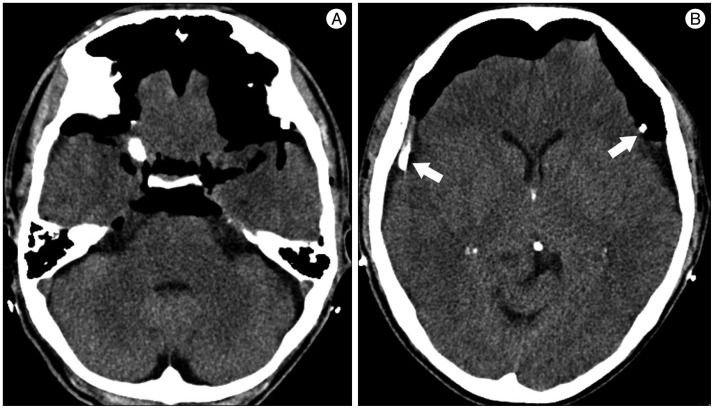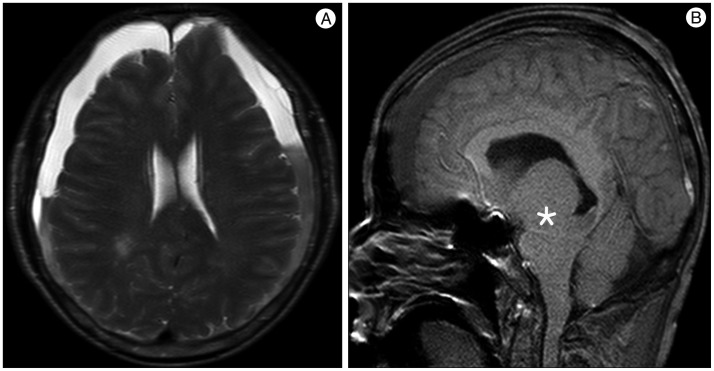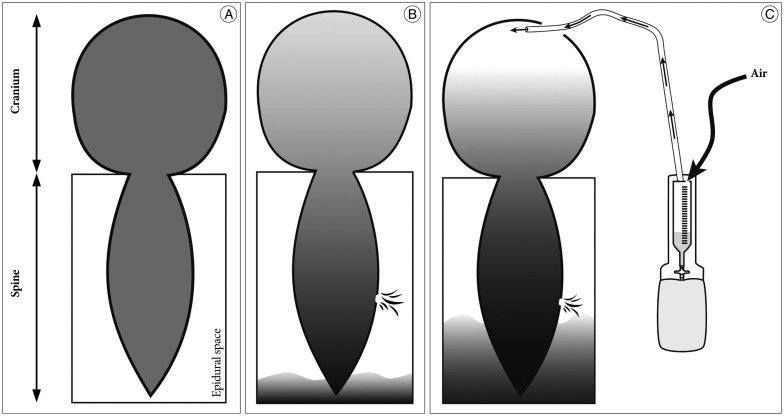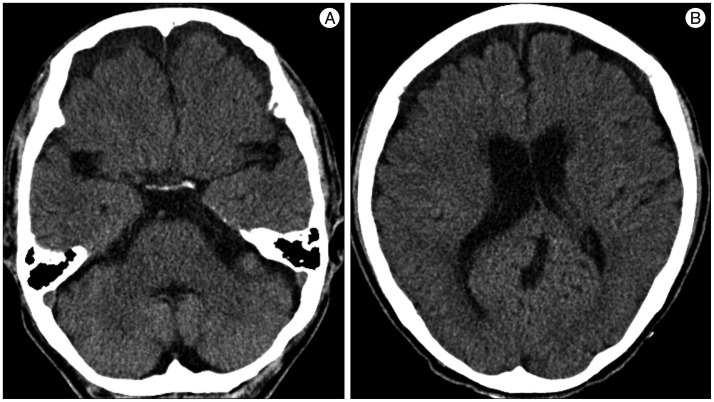1. Ducruet AF, Grobelny BT, Zacharia BE, Hickman ZL, DeRosa PL, Andersen KN, et al. The surgical management of chronic subdural hematoma. Neurosurg Rev. 2012; 35:155–169. discussion 169PMID:
21909694.

2. Fishman RA, Dillon WP. Dural enhancement and cerebral displacement secondary to intracranial hypotension. Neurology. 1993; 43(3 Pt 1):609–611. PMID:
8451008.

3. García-Morales I, Porta-Etessam J, Galán L, Lagares A, Molina JA. Recurrent subdural haematomas in a patient with spontaneous intracranial hypotension. Cephalalgia. 2001; 21:703–705. PMID:
11531906.

4. Gordon N. Spontaneous intracranial hypotension. Dev Med Child Neurol. 2009; 51:932–935. PMID:
19909307.

5. Güler S, Çağlı B, Utku U, Ünlü E, Çelik Y. Intracranial hypotension is a rare cause of orthostatic headache : a review of the etiology, treatment and prognosis of 13 cases. Agri. 2013; 25:69–77. PMID:
23720081.

6. Güler S, Deniz Ç, Utku U, Kehaya S. A case of cerebral venous thrombosis accompanying with intracranial hypotension : headache that changing character. Agri. 2013; 25:141–144. PMID:
24104538.

7. Horowitz M. Intracranial pneumocoele. An unusual complication following mastoid surgery. J Laryngol Otol. 1964; 78:128–134. PMID:
14126276.
8. Ikeda N, Wakabayashi S, Nagao K, Ichioka T, Srivatanakul K, Kajikawa H, et al. [Two cases of spontaneous intracranial hypotension associated with chronic subdural hematoma only treated with burr hole irrigation of the hematomas]. No To Shinkei. 2005; 57:701–707. PMID:
16146215.
9. Inamasu J, Nakamura Y, Orii M, Saito R, Kuroshima Y, Mayanagi K, et al. Treatment of spontaneous intracranial hypotension secondary to C-2 meningeal cyst by surgical packing--case report. Neurol Med Chir (Tokyo). 2004; 44:326–330. PMID:
15253550.

10. Kuramae T, Inamasu J, Nakagawa Y, Nakatsukasa M. Spontaneous intracranial hypotension presenting without orthostatic headache complicated by acute subdural hematoma after drainage for chronic subdural hematoma--case report. Neurol Med Chir (Tokyo). 2011; 51:518–521. PMID:
21785248.

11. Lai TH, Fuh JL, Lirng JF, Tsai PH, Wang SJ. Subdural haematoma in patients with spontaneous intracranial hypotension. Cephalalgia. 2007; 27:133–138. PMID:
17257233.

12. Lee JY, Ebel H, Ernestus RI, Klug N. Various surgical treatments of chronic subdural hematoma and outcome in 172 patients : is membranectomy necessary? Surg Neurol. 2004; 61:523–527. discussion 527-528PMID:
15165784.

13. Lee KS. Natural history of chronic subdural haematoma. Brain Inj. 2004; 18:351–358. PMID:
14742149.
14. Lee KS, Bae WK, Doh JW, Bae HG, Yun IG. Origin of chronic subdural haematoma and relation to traumatic subdural lesions. Brain Inj. 1998; 12:901–910. PMID:
9839025.
15. Markwalder TM. Chronic subdural hematomas : a review. J Neurosurg. 1981; 54:637–645. PMID:
7014792.
16. Morioka T, Aoki T, Tomoda Y, Takahashi H, Kakeda S, Takeshita I, et al. Cerebrospinal fluid leakage in intracranial hypotension syndrome : usefulness of indirect findings in radionuclide cisternography for detection and treatment monitoring. Clin Nucl Med. 2008; 33:181–185. PMID:
18287840.

17. Nardone R, Caleri F, Golaszewski S, Ladurner G, Tezzon F, Bailey A, et al. Subdural hematoma in a patient with spontaneous intracranial hypotension and cerebral venous thrombosis. Neurol Sci. 2010; 31:669–672. PMID:
20730465.

18. Nosik WA. Intracranial hypotension secondary to lumbar nerve sleeve tear. J Am Med Assoc. 1955; 157:1110–1111. PMID:
14353648.

19. Rando TA, Fishman RA. Spontaneous intracranial hypotension : report of two cases and review of the literature. Neurology. 1992; 42(3 Pt 1):481–487. PMID:
1549206.
20. Safain M, Roguski M, Antoniou A, Schirmer CM, Malek AM, Riesenburger R. A single center's experience with the bedside subdural evacuating port system : a useful alternative to traditional methods for chronic subdural hematoma evacuation. J Neurosurg. 2013; 118:694–700. PMID:
23259822.

21. Schaltenbrand G. New perspective on the pathophysiology of CSF flow. Zentrabl Neurochir. 1938; 3:290–300.
22. Schievink WI. Spontaneous spinal cerebrospinal fluid leaks : a review. Neurosurg Focus. 2000; 9:e8. PMID:
16859269.
23. Schievink WI, Maya MM, Moser FG, Tourje J. Spectrum of subdural fluid collections in spontaneous intracranial hypotension. J Neurosurg. 2005; 103:608–613. PMID:
16266041.











 PDF
PDF ePub
ePub Citation
Citation Print
Print




 XML Download
XML Download